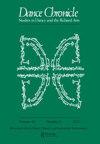比我们想象的更多:中世纪宗教舞蹈的新方法
IF 0.1
3区 艺术学
0 DANCE
引用次数: 0
摘要
中世纪欧洲的舞蹈通常被分为两类:罪恶或神圣,魔鬼之舞或宇宙和谐之舞,莎乐美亵渎神明之舞或大卫王赞美诗之舞。但它可以有很多不同的理解方式——这就是凯瑟琳·迪卡森在她的新书中所展示的。通过对中世纪鼎盛时期和中世纪晚期宗教背景下舞蹈的不同表现形式的令人信服的分析,《救赎的头目:中世纪舞蹈如何变得神圣》展示了舞蹈如何成为基督教虔诚的一种形式。迪卡森是一位对西方中世纪基督教感兴趣的学者。她的研究主题涉及表演、化身、性别和舞蹈。然而,《救赎的头目:中世纪舞蹈如何变得神圣》是她第一本涵盖所有这些主题的书。虽然舞蹈作为宗教实践的一部分这一主题之前已经被研究过,但迪卡森提供了更多的背景和一种新的方法:将舞蹈作为仪式来分析。这本书的主要目的是证明舞蹈(以不同的方式理解)曾经是中世纪宗教生活中不可或缺的一部分。迪卡森从这样的陈述开始:现代基督教是“少数几个将舞蹈排除在其灵修计划之外的宗教之一”(第2页),然后问这是什么时候发生的,为什么会发生。在引言部分,迪卡森简要总结了中世纪舞蹈、中世纪音乐、表演和身体研究的研究现状。她还列举了用于研究中世纪舞蹈的各种方法方法,并指出,即使使用不同种类的书面资料,我们也无法完全理解作为艺术表达的许多舞蹈形式,而且,由于缺乏编舞资料,我们也无法重建舞蹈(第4页)。迪卡森强调,舞蹈的现代定义是有限的,它们无法捕捉到前现代表演背景的丰丰性。本文章由计算机程序翻译,如有差异,请以英文原文为准。
More Than We Think: A New Approach to Medieval Religious Dance
Dance in the European Middle Ages is often studied in binary terms: sinful or holy, devil’s dance or dance of the cosmic harmony, Salome’s sacrilegious dance or King David’s doxological dance. But it can be understood in many different ways—and this is what Kathryn Dickason demonstrates with her latest book. Through compelling analyses of different manifestations of dance in religious contexts in the High and Late Middle Ages, Ringleaders of Redemption: How Medieval Dance Became Sacred shows how dance became a form of Christian piety. Dickason is a scholar interested in Western medieval Christianity. Her research explores topics connected to performance, embodiment, gender, and dance. However, Ringleaders of Redemption: How Medieval Dance Became Sacred is her first book that encompasses all these topics. While the topic of dance as a part of religious practice has been studied before, Dickason provides many more contexts and a new approach: analyzing dance as ritual. The main goal of the book is to prove that dance (understood in different ways) used to be an integral part of medieval religious life. Dickason starts from the statement that modern Christianity is “one of the few religions that excludes dancing from any integral part of its devotional program” (p. 2), then asks when and why this happened. In the introduction, Dickason briefly summarizes the current state of research on medieval dance, medieval music, performance, and body studies. She also enumerates various methodological approaches used in researching medieval dance and points out that, even using written sources of different kinds, we are not able to fully understand numerous forms of dance as artistic expression, nor, because of a lack of choreographic sources, can we reconstruct the dance (p. 4). Dickason emphasizes that modern definitions of dance are limited, and that they cannot capture the richness of pre-modern performative contexts.
求助全文
通过发布文献求助,成功后即可免费获取论文全文。
去求助
来源期刊

DANCE CHRONICLE
DANCE-
CiteScore
0.40
自引率
0.00%
发文量
22
期刊介绍:
For dance scholars, professors, practitioners, and aficionados, Dance Chronicle is indispensable for keeping up with the rapidly changing field of dance studies. Dance Chronicle publishes research on a wide variety of Western and non-Western forms, including classical, avant-garde, and popular genres, often in connection with the related arts: music, literature, visual arts, theatre, and film. Our purview encompasses research rooted in humanities-based paradigms: historical, theoretical, aesthetic, ethnographic, and multi-modal inquiries into dance as art and/or cultural practice. Offering the best from both established and emerging dance scholars, Dance Chronicle is an ideal resource for those who love dance, past and present. Recently, Dance Chronicle has featured special issues on visual arts and dance, literature and dance, music and dance, dance criticism, preserving dance as a living legacy, dancing identity in diaspora, choreographers at the cutting edge, Martha Graham, women choreographers in ballet, and ballet in a global world.
 求助内容:
求助内容: 应助结果提醒方式:
应助结果提醒方式:


